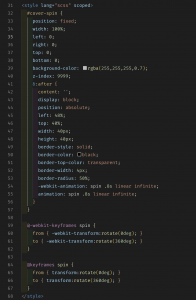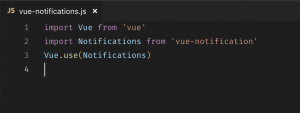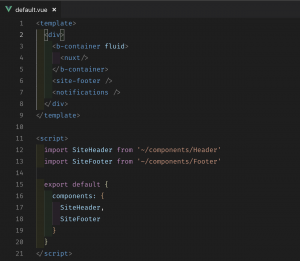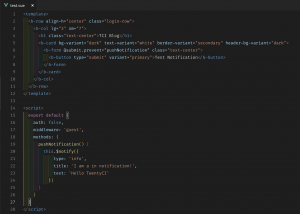Hi everyone, in the last post, we’d set up the project and config it
Today, we go to custom the autoloading effect forNuxt and make an alert notification center. We will use them very often after.
1. Autoloading effect
In many web application, when you click a link or submit a form… the loading icon will appear like a circle or a text like ‘loading…’
By default, Nuxt project has a very simple loading effect. It’s a line color on top of browser run from left to right. And it runs on every router changed or when we force perform it.
But now, I want to make my loading effect. In this case, I’d like it to be a circle with a transparent opacity background. We overwrite the default loading effect of Nuxt
We go to do it now.
First, you can search and make your favorite effect in HTML and CSS.
Then we create a component named “loading.vue” in components folder, its content is very simple, the template and script section just small like this:
 In the template section, it’s just a div tag with id and CSS class, we also add a v-if directive to control it show or hide in script section.
In the template section, it’s just a div tag with id and CSS class, we also add a v-if directive to control it show or hide in script section.
In the script, we declare a ‘show’ property and set up some method to control when it starts, when it finishes, when it fails… For more detail, please see in nuxt default loading component.
The last part of our loading file, we write styles for it:
 That’s all in loading.vue file
That’s all in loading.vue file
And now, the last thing we need to do: open nuxt.config.js file and find the ‘loading’ property. Replace it like below:

It means we use our custom loading component instead of the default.
Easy, right? See the result:
2. Make an alert notification center.
To do this, we use ‘vue-notification’ package
The detail in https://github.com/euvl/vue-notification, install it by running this command in Nuxt root folder (here is web-app):
“yarn add vue-notification”
After choosing the notification type you like, we will create our plugin step by step.
The first, create ‘vue-notifications.js’ in folder plugins:
 Then, we need to add that file into the ‘plugins‘ array property in nuxt.config.js
Then, we need to add that file into the ‘plugins‘ array property in nuxt.config.js
 The last step, we use the ‘ notifications’ directive in the default web layout, so we can use it everywhere:
The last step, we use the ‘ notifications’ directive in the default web layout, so we can use it everywhere:
Layouts/default.vue
 That’s all of the configurations.
That’s all of the configurations.
Now we will test it.
Make a test page: pages/test.vue
 Simple is a button and when clicking on, it will trigger the push notification method.
Simple is a button and when clicking on, it will trigger the push notification method.
In this method, we set some params: type is alert type (success, info, warning, danger…), title is notification title, and the text property is notification description.
Run page, click the ‘Test Notification’ button and see the result:
 Thanks for reading, hope this series ‘s been helpful for you
Thanks for reading, hope this series ‘s been helpful for you
In next post, we will make login using Nuxtauth and Laravel Passport. See you!
Huy Hoang
From Uber to Airbnb, technology is disrupting existing and long standing business models in every corner of industry.
The property industry plays a fundamental role in our lives, for many, a large proportion of their net worth is tied up in their property. But as important as the property industry is, the customer and seller experience hasn’t changed that much in decades. In fact the property industry has been virtually standing still while innovation has been thriving in the digital space.

However this could all now be changing, the UK government published a report in 2013 stating the private rental market has now grow to over 18% of the total market, which accounts for a 24% rise in private renting between 2001-2011* – 1.6 million more renters.
There are 20 million people renting a property in the UK with nearly half (45%) of all prospective home buyers in the UK expecting to remain shut out of the property market, says the Post Office. Many agree that factors such as price and changing lifestyle requirements are behind this shift. This behavioral change towards renting is creating demand for new services that better fit the needs of the market, pulling innovative technology into the space.
PropTech companies make services cheaper and more convenient for consumers through the use of technology, which satisfies consumer needs left unfulfilled by traditional players such as agents and mortgage brokers; challenging the way they do business.
One business already making waves in this space is Fixflo. Their platform allows tenants to easily and quickly submit issues with their property, gathers the relevant information into one document and allows the agent to resolve the problem quickly without the need for lengthy email chains between both parties.
Convenience and efficiency is the name of game here. Within distributed and fragmented markets these two attributes will persuade even the most entrenched industries to migrate to new ways of thinking.
Take the utility industry for example, one renter living with three other housemates has to keep track of different suppliers, chase the financially unreliable housemate (there’s always one) and create some structure to the pile of letters and paper bills that terrorise our door matts. The entire process is painfully inefficient.
Having said that, BillHub already has the answer to this long-standing problem. Their digital platform consolidates suppliers and payments in one centralised Hub (no more letters!), tracks costs, bills housemates individually for their share and provides the user with one point of contact.
Exciting innovation like the ones mentioned, and many more, fundamentally mean renters are now spending less time dealing with problems and more of their free time doing the things that matter to them. In a world where time is arguably the most valuable commodity one can see why renting is becoming as much about lifestyle choice as it is a function of property prices.
* ONS. (2013). Home ownership and renting in England and Wales – Detailed Characteristics. Available: http://www.ons.gov.uk/ons/rel/census/2011-census/detailed-characteristics-on-housing-for-local-authorities-in-england-and-wales/short-story-on-detailed-characteristics.html. Last accessed 20/09/2015.
If the rise of property portals is ‘chapter one’ of the evolution of estate agency, a completely digitized hybrid property sales process is ‘chapter two’, and this part of the story will be fueled by disruptive technologies, such as View My Chain. At least, that’s according to a recent report by investment company Exane BNP Paribas.
‘The future of estate agency: who wins?’ describes the significant changes that the estate agency industry is experiencing due to technological advances, as well exploring how online estate agents are disrupting the traditional bricks and mortar estate agency model. Admittedly, the unshakable grip that property portals have over estate agents has been explored many times. And, I’m sure you’ve read before that online estate agents are ‘the future’. However, the report also goes into detail about the next phase of digitization of the property buying process and how that impacts both estate agents (online and high-street) and property portals.

It’s agreed from both sides of the online/high-street argument that people still want and need human interaction during the sales process. The conclusion drawn in this report is that as online agents impact the industry, high street agents will react, driving a hybridisation of property sales as a whole. The majority of the process will be carried out online, but with a human expert guide (an estate agent). To a certain extent, thanks to property portals, this has already happened: an important segment of the sales process has moved entirely online.
The report states that for hybrid estate agencies to exist effectively, each segment of the sales process needs to be powered by appropriate new technologies that, in many cases, are only just being investigated properly by the industry. It singles out View My Chain as “an innovative new start-up that leverages big data to expedite the post SSTC to completion journey for vendors – a key area of friction in the house sale process.”
Needless to say, View My Chain works for both online and offline estate agency models. It is simply a means of speeding up an existing process through making information available that was previously unattainable or difficult to acquire. However, as the report suggests, the hybrid model of estate agency will depend on such technologies. If as predicted, fees decrease as online competition builds, innovative solutions such as View My Chain may be the difference in reducing time, saving money, keeping the vendor happy, and getting sales over the line.
Sohail Rashid
For a recent publication of Kitchen & Bathrooms News, our Planning Director, Danny Crowe, spoke about the importance of life event marketing and specifically homemovers to kitchen and bathroom retailers.

As a kitchen or bathroom retailer, there’s nothing better than hearing a client say they are moving house. After all, homemovers are the most valuable customers on the planet, generating £12bn incremental annual spend in the UK. Homemovers are eight times more likely to buy a kitchen or bathroom than other consumers. They may only be 5% of the population, at any one time, but they account for more than 25% of spend in the home improvement sector.
How do you find homemovers to market to?
Life event marketing is an effective data-led technique that tracks consumers across key milestones, one of them being moving house. The homemover cycle pans about 18 months, from the moment someone thinks about putting their home on the market until about 12 months after they move in. With homemover data, kitchen and bathroom retailers can pinpoint exactly when potential customers are making major decisions about their home. Successful marketing relies on delivering the right message to the right person at the right time, but life event marketing adds another element – the right context. People who are about to buy, or have just bought a house have a much higher propensity to buy than other consumers, so the communications you deliver during that time are likely to be more effective.
In the pre-move phase, your message should be about inspiration. Don’t bombard them with offers. Give them ideas about how their new kitchen or bathroom could look and let them know you’re there when they’re ready. Once they’ve moved in, they are in purchase mode. This is the time to deliver relevant sales messages. Make sure the price point is right, based on the price of their property. As a rule, customers will spend about 1.5% of the property value on a new kitchen. This consideration should follow through to your retail displays. While luxury kitchens with big islands and AGAs may look attractive, it’s the smaller kitchens that may be more relevant.
Using life event data you can also identify consumers undergoing major home improvements. People who have applied for planning permission are more likely to be in the market for a kitchen or bathroom. Another interesting trigger is equity release. People who take money out of their homes have a high propensity to buy a kitchen or bathroom. Homemover data also helps you to exclude segments that are not relevant, such as renters or people moving into a new build. Driving desire and inspiration to a highly targeted audience can only increase showroom footfall and, ultimately, sales.
Updated daily with details of 99.6% of UK movers at the pre-move stage, TwentyCi’s Homemover database is the most in-depth and accurate in the UK. For more information about how TwentyCi can help with your Life Event Marketing, please leave your information below or email us